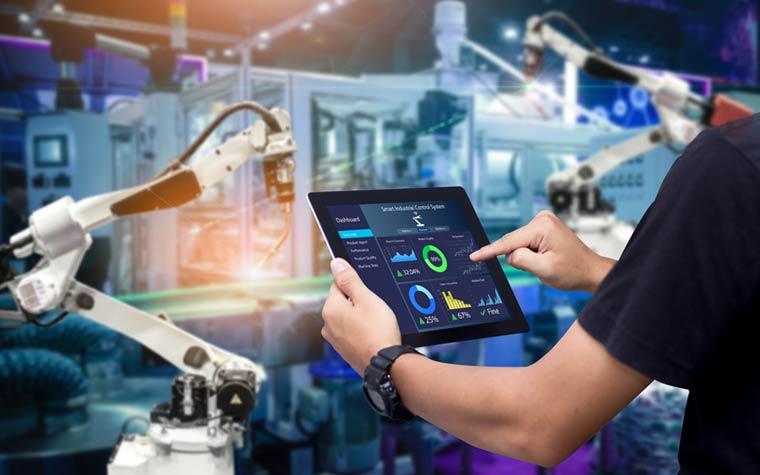
How IIoT Helps Achieve Compliance and Sustainability in Industrial Operations?
The integration of Industrial Internet of Things (IIoT) technologies into industrial operations has revolutionized how businesses manage processes, compliance, and sustainability. By connecting physical devices and systems to the digital world, IIoT enables real-time monitoring, automation, and data-driven decision-making.
In today’s industrial landscape, the focus on compliance and sustainability is paramount. Industries are under increasing pressure to meet regulatory requirements, minimize environmental impacts, and ensure resource efficiency.
This blog explores how IIoT can help businesses achieve compliance and sustainability in their operations, providing a framework for long-term success.
Understanding IIoT in Industrial Operations
IIoT refers to the network of interconnected devices, sensors, machinery, and software that collect, exchange, and analyze data to improve industrial efficiency and safety. These devices communicate through the cloud, offering real-time insights into production processes, equipment health, energy usage, and much more.
The applications of IIoT range from predictive maintenance and remote monitoring to automating complex industrial tasks, making it an essential tool for achieving both compliance and sustainability goals.
The Role of Compliance in Industrial Operations
Compliance in industrial operations refers to adhering to the laws, regulations, and standards set by governing bodies. These regulations are designed to ensure the safety, environmental responsibility, and ethical conduct of industries. Failing to meet these standards can result in legal penalties, financial losses, and damage to the company’s reputation.
The Sustainability Imperative
Sustainability is the practice of conducting business in a way that minimizes negative environmental impact, conserves natural resources, and supports long-term ecological balance. For industrial operations, sustainability means reducing energy consumption, minimizing waste, and adopting eco-friendly practices.
Achieving sustainability often requires industries to rethink their processes, adopt cleaner technologies, and invest in innovations like IIoT that can track and optimize resource use.
How Does IIoT Help Achieve Compliance?
Real-Time Monitoring and Reporting
One of the most critical aspects of compliance is the ability to monitor and report on key operational metrics such as emissions, energy use, and waste management. IIoT enables real-time monitoring of these metrics, providing companies with immediate insights into their performance against regulatory standards.
Sensors connected to IIoT systems can track air quality, wastewater discharge, and energy consumption, allowing businesses to identify non-compliant activities and take corrective action before violations occur.
Additionally, IIoT systems can automate the reporting process, making it easier for companies to meet compliance documentation requirements. By having data continuously available and organized in the cloud, businesses can provide accurate and timely reports to regulatory authorities, reducing the risk of non-compliance.
Predictive Maintenance for Safety and Compliance
Safety regulations in industries such as oil and gas, manufacturing, and chemical processing require that equipment operates efficiently without endangering workers or the environment. IIoT plays a significant role in maintaining equipment safety by enabling predictive maintenance.
Predictive maintenance uses IIoT sensors to monitor the health of machines and detect potential issues before they cause failures. This not only prevents costly downtime but also ensures that equipment is functioning within regulatory safety standards.
For example, temperature and vibration sensors in a manufacturing plant can detect anomalies in machinery, prompting preemptive repairs that maintain safety and avoid regulatory infractions. Predictive maintenance helps companies avoid compliance penalties related to machine failures or safety breaches, while also reducing unnecessary maintenance activities.
Data-Driven Decision Making
Industrial compliance regulations are complex and often require informed decision-making at all levels of the organization. IIoT provides the data and insights necessary for these decisions. By analyzing data from sensors and devices, companies can make data-driven decisions that align with compliance goals.
For instance, an energy-intensive industry can use IIoT data to identify energy inefficiencies and optimize energy consumption, reducing greenhouse gas emissions and meeting regulatory targets.
IIoT also enables businesses to benchmark their operations against industry standards, identifying areas where they can improve compliance. Access to real-time data helps companies remain agile in responding to changes in regulations, as they can quickly adjust their processes to stay within legal boundaries.
How Does IIoT Drive Sustainability?
Energy Efficiency
One of the primary ways IIoT promotes sustainability is through energy efficiency. IIoT-enabled energy management systems can monitor and optimize the use of energy in industrial processes. By identifying patterns in energy consumption, IIoT systems can recommend adjustments to reduce energy waste.
For instance, IIoT sensors can detect when equipment is running inefficiently or consuming more energy than necessary, allowing businesses to take corrective actions.
The ability to track and analyze energy consumption in real-time ensures that industrial operations can continuously optimize their processes to minimize energy use. This not only reduces operational costs but also lowers the company’s carbon footprint, contributing to long-term sustainability.
Resource Optimization
IIoT helps industries manage and optimize the use of resources such as raw materials, water, and chemicals. For example, in the manufacturing sector, IIoT sensors can monitor the amount of raw material used in production processes, ensuring that materials are not wasted and that production is as efficient as possible. In sectors like agriculture and water management, IIoT can help optimize the use of water resources, minimizing waste and ensuring sustainable use.
By minimizing resource consumption, companies can improve their sustainability profile while also reducing costs. Additionally, this optimization reduces the environmental impact of industrial processes, making them more sustainable in the long run.
Waste Management
Effective waste management is a critical component of sustainability. IIoT can monitor and control waste in real-time, ensuring that waste is minimized and properly managed. In industries like chemical processing, IIoT systems can track hazardous waste production and ensure that it is disposed of according to regulatory requirements. IIoT can also help industries recycle materials more efficiently by monitoring the quality and quantity of recyclable waste.
By integrating IIoT into their waste management processes, companies can reduce the environmental impact of their operations and comply with waste disposal regulations.
Sustainable Supply Chain Management
IIoT extends beyond individual operations to the entire supply chain. By connecting suppliers, manufacturers, and distributors, IIoT enables more efficient supply chain management. Real-time data on inventory levels, transportation routes, and production schedules can help companies optimize their supply chains, reducing waste and emissions.
For example, IIoT systems can track the carbon footprint of transporting goods and suggest alternative routes that minimize environmental impact. Sustainable supply chain management not only reduces costs but also helps companies meet sustainability goals.
How Can an Engineering Services Firm Help?
Engineering service firms play a crucial role in helping companies implement IIoT solutions that drive compliance and sustainability. These firms offer expertise in designing and deploying IIoT systems that are tailored to specific industrial needs. From selecting the right sensors and devices to integrating IIoT platforms with existing infrastructure, engineering services firms ensure that companies can maximize the benefits of IIoT.
Additionally, these firms provide ongoing support and maintenance for IIoT systems, ensuring that they continue to operate efficiently and effectively. Engineering services firms also help businesses stay compliant with evolving regulations by updating IIoT systems to reflect new requirements. With their technical expertise and industry knowledge, engineering service firms are essential partners in achieving compliance and sustainability through IIoT.
Thus, IIoT has become a critical tool for industries seeking to improve compliance and sustainability. By enabling real-time monitoring, predictive maintenance, energy efficiency, and resource optimization, IIoT helps companies meet regulatory requirements while minimizing their environmental impact. Partnering with an engineering services firm can further enhance the effectiveness of IIoT solutions, ensuring that businesses can achieve long-term success in both compliance and sustainability.
The Industrial Internet of Things (IIoT) is transforming the industrial landscape by connecting machines, sensors, and devices, enabling real-time data collection and analysis. This connectivity brings unprecedented efficiency, productivity, and innovation opportunities. However, it also introduces significant cybersecurity risks. As industrial systems become increasingly interconnected, they become more vulnerable to cyber threats, making the security of IIoT systems paramount.
In this blog, we will explore the importance of securing IIoT systems and provide strategies to mitigate cyber threats, addressing the concerns of clients worried about data breaches and security risks.
The Importance of Securing IIoT Systems
- Protecting Critical Infrastructure
IIoT systems are often integrated into critical infrastructure, such as power grids, water treatment facilities, and transportation systems. A cyber attack on these systems can have catastrophic consequences, leading to service disruptions, safety hazards, and economic losses. Ensuring the security of IIoT systems is essential to protect public safety and maintain the continuity of essential services.
- Safeguarding Sensitive Data
IIoT systems collect vast amounts of data, including operational information, production metrics, and even employee and customer data. This data is valuable to cybercriminals who can exploit it for financial gain or industrial espionage. Securing IIoT systems helps protect sensitive data from unauthorized access and theft.
- Maintaining Operational Continuity
Cyber attacks can disrupt industrial operations, leading to downtime and productivity losses. For instance, a ransomware attack can lock down critical systems, forcing companies to halt production until the issue is resolved. By securing IIoT systems, companies can minimize the risk of operational disruptions and ensure business continuity.
- Compliance with Regulations
Many industries are subject to strict regulations regarding data protection and cybersecurity. Non-compliance can result in hefty fines, legal penalties, and reputational damage. Implementing robust IIoT security measures helps companies comply with regulatory requirements and avoid potential legal and financial repercussions.
Strategies to Mitigate Cyber Threats in IIoT Systems
- Implementing Strong Authentication and Access Controls
One of the most effective ways to secure IIoT systems is by implementing strong authentication and access controls. This includes using multi-factor authentication (MFA) to verify user identities and restricting access to sensitive systems and data based on the principle of least privilege. Role-based access control (RBAC) can help ensure that users only have access to the resources they need for their specific roles.
- Encrypting Data at Rest and in Transit
Data encryption is crucial for protecting sensitive information from unauthorized access and tampering. Encrypting data at rest ensures that even if an attacker gains physical access to storage devices, they cannot read the data without the encryption key. Encrypting data in transit protects it from interception and eavesdropping as it moves between devices and systems. Implementing end-to-end encryption ensures that data remains secure throughout its lifecycle.
- Regularly Updating and Patching Systems
Keeping IIoT devices and systems up to date with the latest software patches and security updates is essential for protecting against known vulnerabilities. Cybercriminals often exploit unpatched vulnerabilities to gain access to systems and networks. Regularly updating and patching systems helps close these security gaps and reduces the risk of exploitation.
- Segmenting Networks
Network segmentation involves dividing a network into smaller, isolated segments to limit the spread of cyber threats. By segmenting IIoT networks, companies can contain the impact of a potential breach and prevent attackers from moving laterally across the network. Implementing firewalls, virtual local area networks (VLANs), and intrusion detection systems (IDS) can help enforce network segmentation and enhance security.
- Monitoring and Analyzing Network Traffic
Continuous monitoring and analysis of network traffic can help detect and respond to cyber threats in real time. Implementing intrusion detection and prevention systems (IDPS) can alert security teams to suspicious activity and block malicious traffic.
Advanced threat detection tools, such as Security Information and Event Management (SIEM) systems, can provide comprehensive visibility into network activity and facilitate rapid incident response.
- Implementing Robust Endpoint Security
IIoT devices often have limited security features, making them attractive targets for cybercriminals. Implementing robust endpoint security measures, such as anti-malware software, intrusion prevention systems, and device management solutions, can help protect IIoT devices from cyber threats. Regularly updating firmware and applying security patches is also essential for maintaining the security of IIoT endpoints.
- Conducting Regular Security Assessments and Penetration Testing
Regular security assessments and penetration testing can help identify vulnerabilities in IIoT systems before cybercriminals can exploit them. Conducting these assessments allows companies to proactively address security weaknesses and strengthen their defenses. Engaging third-party security experts to perform penetration testing can provide an unbiased evaluation of the security posture and identify potential areas for improvement.
- Implementing Security Policies and Employee Training
Establishing comprehensive security policies and procedures is essential for guiding the organization’s approach to IIoT security. These policies should cover aspects such as access control, data protection, incident response, and employee responsibilities. Additionally, providing regular cybersecurity training to employees helps raise awareness about cyber threats and promotes best practices for maintaining security. Employees should be educated on how to recognize phishing attempts, secure their devices, and report suspicious activities.
As IIoT systems continue to revolutionize industrial operations, securing these systems against cyber threats becomes increasingly critical. The potential consequences of a cyber attack on IIoT systems, including service disruptions, data breaches, and operational downtime, underscore the importance of robust cybersecurity measures.
By implementing strong authentication and access controls, encrypting data, regularly updating systems, segmenting networks, monitoring network traffic, securing endpoints, conducting security assessments, and fostering a security-aware culture, companies can effectively mitigate cyber threats and protect their industrial assets in a connected world.
Securing IIoT systems is not just a technical challenge; it is a strategic imperative that requires ongoing vigilance and commitment. By prioritizing cybersecurity and adopting a proactive approach, companies can harness the full potential of IIoT while safeguarding their critical infrastructure, sensitive data, and operational continuity. In an era where cyber threats are constantly evolving, a comprehensive and adaptive IIoT security strategy is essential for ensuring a resilient and secure industrial environment.


